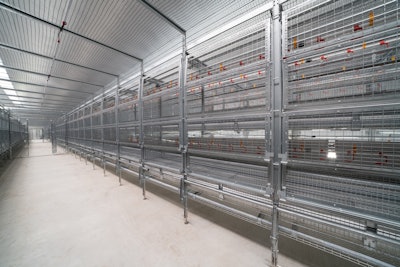
A self-training system that allows pullets to transition more easily into cage-free or free-range housing could help reduce bird injuries, decrease labor and increase producer profit.
When pullets are transferred into the cage-free layer house, either with or without outdoor access, producers will often see bird injuries and eggs laid outside the nesting area. Pullet housing systems that encourage birds to move, jump and fly across movable platforms while they are young could help reduce issues for the pullets when they are moved to open housing environments for egg production.
Mari van Gruijthuijsen, Hellman Poultry Equipment business development manager, believes that pullets reared in this type of system have stronger muscles and bones due to their activity level before the system’s doors are opened, leading to less injury. In many other pullet systems, birds are required to learn these behaviors after the doors are opened, which can cause issues.
Bird training can start at the earliest possible time, and much sooner compared to previous designs. Even though these former designs have worked well, explained Gruijthuijsen, experiences and insights have led to a next generation model.
“In this system, birds can be trained using movable platforms between approximately 1 – 35 days of age, and by the time they get released, they have already developed bone and muscle structure and are mentally ready to jump and fly,” he said.
Because the pullet rearing system produces birds that are self-trained to jump and fly earlier than many other pullet systems allow for, producers have less work in moving the birds throughout the house.
Gruijthuijsen explained the rearing system was developed over the last few years and had positive results at commercial farms in Canada, The Netherlands, Germany, Finland and Poland. “Six to seven producers have the system installed,” he said. “Now it is ready to be released and announced at a much larger scale.”
 Courtesy Hellman Poultry Equipment
Courtesy Hellman Poultry Equipment
How the self-training works
Day old chicks are introduced into the base level of the system. As they start to grow, the internal platforms are moved and the drinking lines are placed higher in the system, encouraging birds to start learning how to jump and fly. As the pullets grow bigger, the platforms continue to move, along with the drinker lines, creating more areas for bird activity.
When the birds are large enough for the system doors to be opened, they are better able move between systems. “At this time, the birds are already more physically prepared to leave the system,” he added.
The platforms can be moved manually or automatically while the birds are in the system. Gruijthuijsen said the number of birds that can be reared in each system depends on the country regulations but is approximately 250-300 pullets per unit.
“What’s unique about this system is that birds are forced to go further than they would without any encouragement,” said Janin Noah, Hellman Poultry Equipment marketing coordinator. “Sometimes there are lazy birds that will not move to higher platforms by themselves, but when some of the more agile ones find the water quickly, the other ones and follow them.”


















